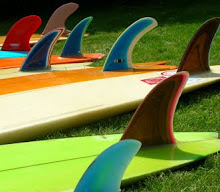A bit more about Hayden spoons. Gavin from Australia saw mine and sent in photos of his Hayden which also has the red velo design on. This ones a fully flexi spoon at the tail, with white pigment on the deck and underside so not a see through one. Its got a lovely Greenough fin, maybe mine would have been like this originally, just a bit longer at the base. This board will soon be in a british collection, not mine, but it will be good to put them together and compare the differences. Gavin says - ''Mine is completely original, untouched and was bought new by the original owner in Rainbow beach circa 1968/9. Interestingly, he was a stand up rider who saw footage of greenough and wanted the feel that was happening with spoons. I have actually come across this a couple of times, where spoons have been owned by stand up surfers, rather than kneels''
George Greenough's name started to become well known in the surfing world when Nat Young won the worlds in 1966 on a revolutionary 9'4, thinner than most and with a flexible fin designed by Greenough. By the 1968 worlds all competitors boards had fins based on Greenough designs.
And Greenough's kneeboard surfing showed the Aussies that no matter how much they tweaked their longboards, they would never match the performance of GG's spoon. Thus started the shortboard revolution which eventually (many years later and after some dead end design phases) allowed stand up surfers to match GG's performance levels kneeling.
In the late 50s/ early 60s GG was making 5 ft long dished deck balsa kneeboards, originally twin fins but he found the closer he put the fins together the better it went so it became a singlefin, based on dolphin dorsal fins. His first spoon was Velo in 1965, a pure fibreglass shell which used the bottom of his balsa kneeboard as a mould. He shaped some leftover bits of foam for floatation at the rails and glassed them on, and ground the tail till it reached a desired flexibility under the load of a heavy turn. He now had an efficient straight rocker when he was planing, and a manouverable curved one when he was turning. This had never been seen before in a surfboard, and 40+ years later his spoons still stand as pretty advanced thinking.
Velo was barely able to float itself, and needed swim fins, or when GG had a camera ,an extra air mattrees for floatation to paddle out .It also needed good waves, fast and powerful. Once on a decent wave, it sat naturally in the pocket, and allowed George to go deep in the barrel, zip out onto the flat part of the wave and cut back into the white water with a conviction not seen before in stand up surfing. He blew minds, and was one of the few Americans the Aussies gave major respect to !
As most of you know, George's creativity went beyond just designing and riding the spoon - he made some great films including the Innermost limits of pure fun, Crystal Voyager and Dolphin Glide, designed and made windsurf boards, boats and a yacht, mat surfing, the list goes on.
In around 1965 George left his native Santa Barbara for a trip to Australia. He visited fellow American Bob Cooper who was working at Hayden Kenny's at Alexandra Headlands. Bob McTavish was also working at Hayden, and he and George soon became surfing buddies, especially at the newly found Noosa. McTavish and the Hayden shapers quickly got new ideas about how a surfboard could perform, and straight away copied George's narrow based fin based on a blue fin tuna. This soon became the world standard, but it started with George and then with Hayden.
In 1966 McTavish produced his first v bottom (around the fin area) on a 9ft board made for Hayden glasser Mick Hopper. By 1967 McTavish had moved down to Keyo in Sydney and was making v bottom plastic machines of 9 ft, the 8'6, then 8 ft , and the length kept dropping. They were the most responsive stand up surfboards ever made at the time. And so the shortboard revolution began. Within a year v bottoms had been dropped in favour of flat bottoms.
McTavish and George were still good friends and when Bob visited George in California they were the only two shortboarders in the US ; whereas back in Australia most companies were putting out versions of the new plastic machine design.
Rare twin fin Hayden spoon, only a few were made and most of these were exported to the US.
The Hayden shop in 1965. The board with the white fin is Algie Grud's, and was the first conventional longboard to have a Greenough flex fin.Three generations of Greenough fins, 1962 from a balsa dished deck board, 1965 from the fibreglass Velo and a highly evolved mid 70s fin.
George's favourite Velo (mk 2) above, and below how it was made by using the original balsa Velo as a mould, and then adding some foam offcuts around the rails.



















.jpg)





thank you very much.... GG was a Genius and everybody has to gas!
ReplyDelete....has to know! Sorry....
ReplyDeleteglad you enjoyed the post, ive only scratched the surface really !
ReplyDelete